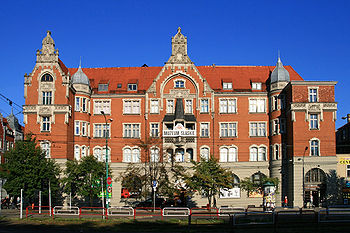
Silesian Museum
Encyclopedia

Katowice
Katowice is a city in Silesia in southern Poland, on the Kłodnica and Rawa rivers . Katowice is located in the Silesian Highlands, about north of the Silesian Beskids and about southeast of the Sudetes Mountains.It is the central district of the Upper Silesian Metropolis, with a population of 2...
, Poland
Poland
Poland , officially the Republic of Poland , is a country in Central Europe bordered by Germany to the west; the Czech Republic and Slovakia to the south; Ukraine, Belarus and Lithuania to the east; and the Baltic Sea and Kaliningrad Oblast, a Russian exclave, to the north...
.
History
The museum was founded in 1929 by the Silesian Sejm, while the region was recovering from the Silesian UprisingsSilesian Uprisings
The Silesian Uprisings were a series of three armed uprisings of the Poles and Polish Silesians of Upper Silesia, from 1919–1921, against German rule; the resistance hoped to break away from Germany in order to join the Second Polish Republic, which had been established in the wake of World War I...
. In the interbellum, the Silesian Museum was one of the biggest museums in Poland. The Nazis however brought the collection to Bytom
Bytom
Bytom is a city in Silesia in southern Poland, near Katowice. The central-western district of the Upper Silesian Metropolitan Union - metropolis with the population of 2 millions. Bytom is located in the Silesian Highlands, on the Bytomka river .The city belongs to the Silesian Voivodeship since...
and tore the building down in 1940. In 1984 the museum was reinstated in a former hotel building.
Collection
Mainly ethnological and archaeological artefacts from the surrounding area, related to the History of SilesiaHistory of Silesia
Silesia has been inhabited from time immemorial by people of multiple ethnic groups. Germanic tribes were first recorded within Silesia in the 1st century. Slavic White Croats arrived in this territory about the 6th century establishing White Croatia. The first known states in Silesia were those of...
. Furthermore some 233 works of Polish art, with as remarkable examples portraits by Stanisław Wyspiański and some paintings by Olga Boznańska
Olga Boznanska
Olga Boznańska , was a Polish painter.Daughter of railway engineer Adam Nowina Boznański and Eugenia Mondan. Boznańska learned drawing from Józef Siedlecki and Kazimierz Pochwalski and studied at the Adrian Baraniecki School for Women. From 1886-1890 she studied in private schools of Karl...
. Other artists on display from the original collection, returned from Bytom, are:
- Jan Cybis
- Tadeusz MakowskiTadeusz MakowskiTadeusz Makowski was a prominent Polish painter active in France for most of his life. He was born in Oświęcim. Makowski attended the Academy of Fine Arts in Kraków. He studied under Jan Stanisławski and Józef Mehoffer. In 1909, he departed for Paris. Makowski started off as a landscape painter...
- Józef MehofferJózef MehofferJózef Mehoffer was a Polish painter and decorative artist, one of the leading artists of the Young Poland movement and one of the most revered Polish artists of his time.-Life:...
- Piotr Michałowski
- Tymon Niesiolowski
- Stanisław Witkiewicz
- Witold WojtkiewiczWitold WojtkiewiczWitold Wojtkiewicz was a Polish neoromantic painter. He started his education at the Warsaw School of Drawing in 1898 and continued at the Academy in Kraków. His original and inventive work anticipated Polish Expressionism. Wojtkiewicz often employed grotesque motifs and irony in his work...
More contemporary artists on display are:
- Edward Dwurnik
- Adam MarczyńskiAdam MarczynskiAdam Marczyński was a Polish painter. He died in Kraków.Marczyński came into his own as an artist of post-war Kraków....
- Andrzej WróblewskiAndrzej WróblewskiAndrzej Wróblewski was a Polish painter who died in a mountaineering accident in 1957 when he was only 29. He is recognized by many as one of Poland's most prominent artists in the early post World War II era, creating an individualistic approach to figurative painting.-Early life:Wróblewski was...
Furthermore there are historical objects and artefacts from the region, such as a flask vessel.

